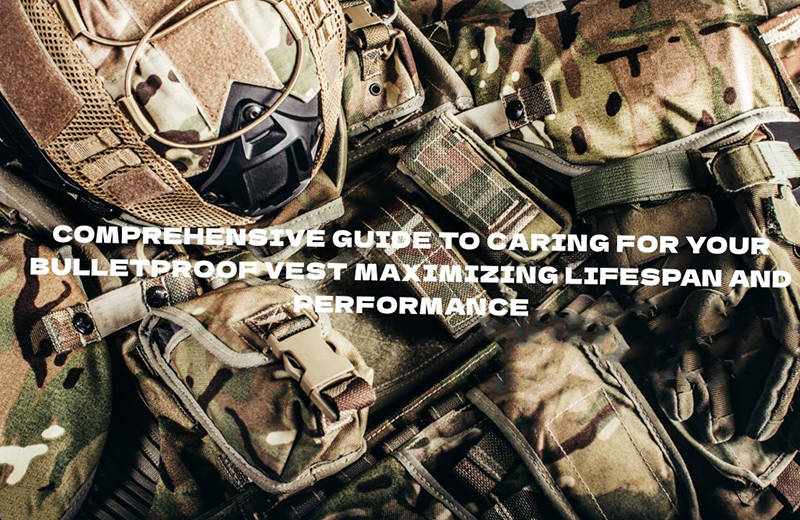No products in the cart.

Introduction
When it comes to protecting the lives of individuals who work in law enforcement and security, a bulletproof vest is more than just a piece of equipment. The wearer’s safety and well-being depend on the dependability and efficacy of this protective equipment. However, wearing a bulletproof vest doesn’t mean you’re ready to go. Maintenance is crucial if you want to keep your vest’s ballistic capabilities intact and use it for a long time. In this detailed manual, we’ll go over everything you need to know about maintaining your body armor, from how to clean it to how to store it, and even some expert tricks for getting the most out of it. If you take care of your bulletproof vest as instructed, it will protect you effectively for many years to come.
The Importance of Proper Care for Your Body Armor
You’ve made a wise choice in purchasing a bulletproof vest for your protection. To maximize the value and usefulness of any investment, regular maintenance is essential. If you don’t take care of your body armor, it will lose some of its protective qualities against bullets and you won’t be as safe in dangerous situations. You can ensure that your ballistic vest continues to perform at its best when you need it by taking preventative measures and following the manufacturer’s instructions.
Understanding the Components of Your Bulletproof Vest
To properly care for your bulletproof vest, you must first have a firm grasp on its constituent parts.
Carrier
The comfortable and protective outer fabric casing houses the ballistic panels.
Ballistic Panels
What makes a bulletproof vest effective are the ballistic panels, which are made up of multiple layers of high-strength fibers laminated together.
Trauma Pad (Optional)
Extra padding or foam inserts cushion falls and lessens the severity of falls by absorbing some of the impact force.
The Cleaning Process: Do’s and Don’ts
Cleaning your bulletproof vest is an important part of upkeep, but you must take care not to damage the ballistic material in the process. Some cleaning musts and avoidances for your body armor are as follows:
Do’s:
Follow Instructions:
- Always check the manufacturer’s instructions for proper maintenance and cleaning. Your vest’s materials and construction merit these particular care requirements.
Frequent spot cleaning:
- You may spot-clean your vest by wiping it down with a damp cloth or sponge and some mild soap and water to get rid of any surface dirt and stains. Scrub the afflicted areas gently and dry them off with a clean towel.
Use a Soft Brush:
- To prevent fabric or ballistic panel damage, use a soft-bristled brush on dirt and debris that just won’t budge.
Air Dry Only:
- Please hang your vest to dry in a cool, shady area after washing. The ballistic fibers can be damaged by exposure to extreme heat or sunlight.
Don’ts:
Machine Washing:
- Never put your body armor in the washing machine or tumble dryer, since doing so could permanently destroy the ballistic panels and render them useless.
Using Chemicals:
- Avoid Using Bleach and Harsh Chemicals. Ballistic materials can deteriorate if cleaned with bleach or other harsh chemicals.
Avoid Dry Cleaning:
- The chemicals used in dry cleaning might break down the ballistic fibers in your vest, so don’t do it.
Putting Away Your Body Armor
Keeping your vest in good condition for its intended purpose and use requires careful storage. Keep these things in mind when stowing your body armor:
Your body armor will last longer if you keep it in a cool, dry environment with low to medium humidity. The ballistic substance may be damaged by exposure to high temperatures.
When not in use, lay your vest flat or hang it up using a hanger that can handle its weight. You can keep your vest’s shape and prevent creases in the ballistic panels by hanging it up.
Always store and transport your armor in a suitable bag or cover to prevent damage from dust and other environmental conditions.
Pro Tips for Extending the Lifespan of Your Body Armor
Regular Inspection
Maintain a routine inspection schedule to check for damage or wear on your vest. If you find any signs of wear, such as loose threads, tears, or delamination, the manufacturer can advise you on how to proceed.
Rotate Carriers
If your organization allows it, have numerous carrier vests and switch them out periodically. This gives each vest plenty of time to dry after use, preventing the buildup of sweat and unpleasant odors.
Use a Moisture-Wicking Shirt
Wear a Moisture-Wicking Shirt Under Your Vest One way to keep dry and comfortable while reducing wear on your vest’s ballistic panels is to wear a moisture-wicking shirt underneath it.
Avoid Excessive Weight
Do not overload the vest with heavy goods, since this will put undue stress on the material and attachments.
